Goat Cheese vs. Feta Cheese
When you buy through our links, The Breslin may earn an affiliate commission. Learn more
Goat cheese vs Feta cheese? Even if you’re not a cheese geek, you know what they share in common: they’re both made from milk. Is there any cheese on earth that does not come from milk?
However, the similarity almost stops there! Goat cheese and Feta cheese are quite distinct, contributing to the mosaic of the cheese-making world. And as a cheese enthusiast, I adore the diverse tastes and flavors that different types of cheese offer.
To dig deeper into the differences between these two cheese variants, it’s important to factor in their source of milk, origin, the cheese-making process, and more. I would like to share that with you all in this article!
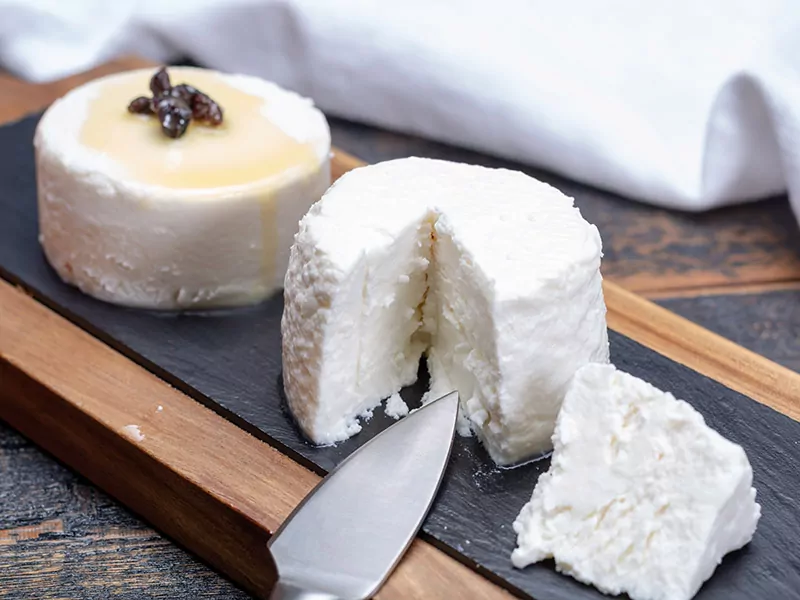
What Is Goat Cheese?
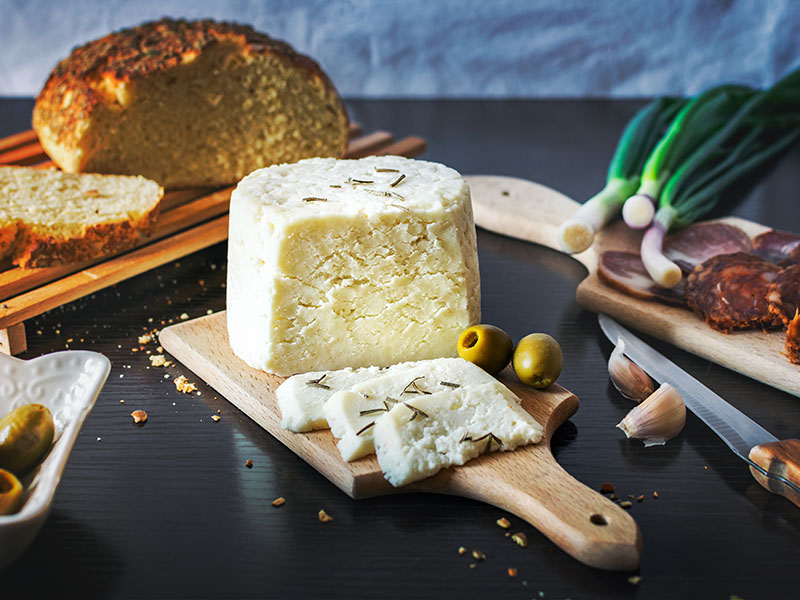
Goat cheese is a white, creamy cheese made from goat’s milk. It also goes by the name chevre, which means “goat” and “goat cheese” in France. Numerous goat cheese varieties are available in many cheese-producing factories worldwide.
The most well-known are Humboldt Fog, Goat Gouda, Crottin de Chavignol, Bleu du Bocage, Queso de Murcia al Vino, and the list goes on.
What Is Feta Cheese?
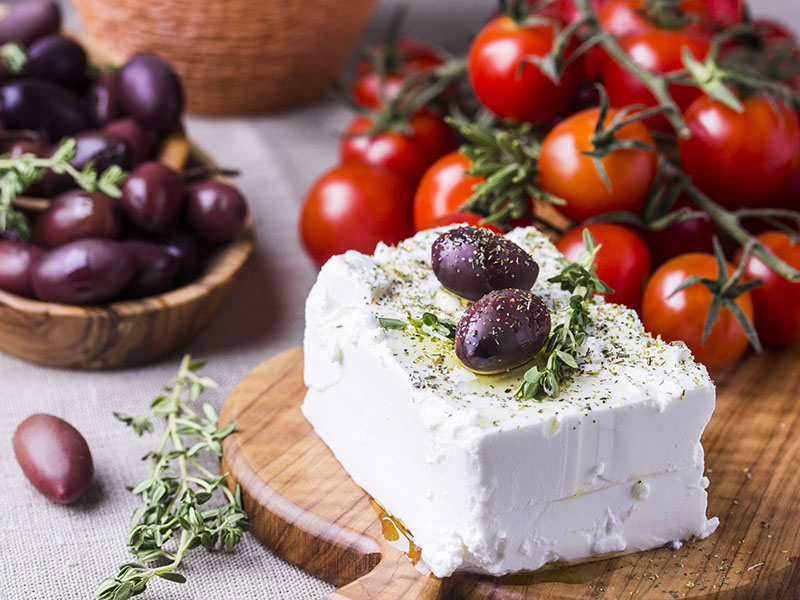
Feta derives from the Italian word fetta, which means “slice”. Feta is a brined white-colored cheese, meaning it constantly stays in brine during the ripening process.
Unlike goat cheese, Feta is a more specific cheese and doesn’t have variety. Authentic Feta is only the cheese that comes from approved regions in Greek according to certain specifications.
Nevertheless, the production of Feta does not only occur in Greece. Other countries such as France, Bulgaria, and Israel have their share of Feta manufacturing, with variegated recipes and techniques.
Let’s look into the making of the true Greek Feta cheese.
Goat Cheese Vs Feta Cheese – Key Similarities And Differences
There are various factors to differentiate Feta from goat cheese. By tracing their origin, analyzing their production processes, and comparing the type of milk used, I pinpoint the most significant distinctions between these two kinds of cheese.
Origin
Let’s begin with the history! Goat cheese and Feta cheese didn’t come from the same homeland, contributing to many differences.
Goat Cheese
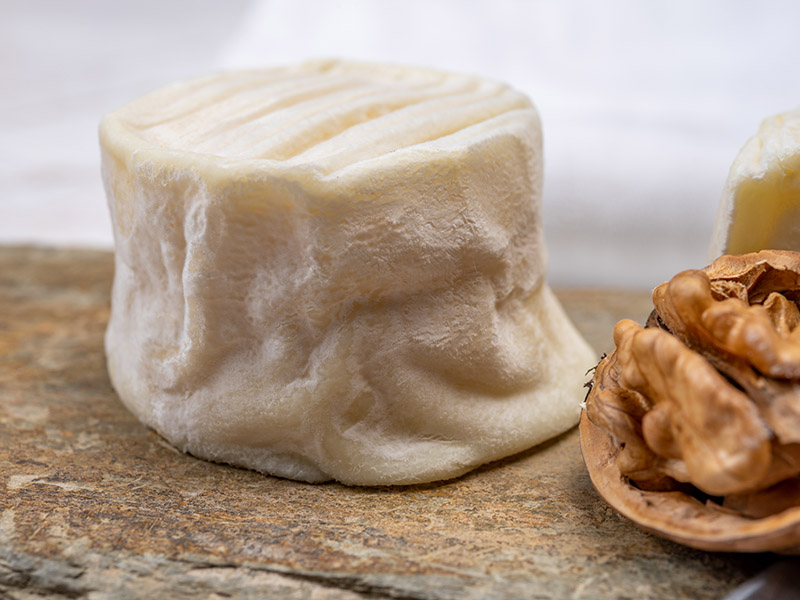
The production of goat cheese started not long after the domestication of goats. In the 8th century, the Moors withdrew from France following the Battle of Poitiers, leaving behind their goats.
The people in the valley of Loire River Valley, France, kept these goats and started using their milk to make cheese. Today, French goat cheese successfully leaves a huge mark on the cheese map.
Here’s a sneak peek into goat cheese manufacturing from A to Z.
Feta Cheese
Any effort to pinpoint the origin of Feta only leads a researcher into a quicksand. Cheese produced from goat or sheep milk has been a popular commodity in Eastern Mediterranean since ancient times.
Evidence from the Bronze Age Canaan also shows rennet-coagulated white cheese soaked in brine, which resembled Feta cheese, was commonly transported by ships. Yet, the evidence is not conclusive.
The oldest documentation about the existence of sheep’s milk cheese is Homer’s legendary 8th century BC poem – The Odyssey. However, it’s more likely that the sheep’s milk cheese existed long before that.
The Odyssey belongs to Greek mythology, so it’s common to assume that Greek is where Feta originally comes from.
That said, Feta cheese is a regional product, varied in flavors and textures by region. Other significant producers include Bulgaria, France, and Israel.
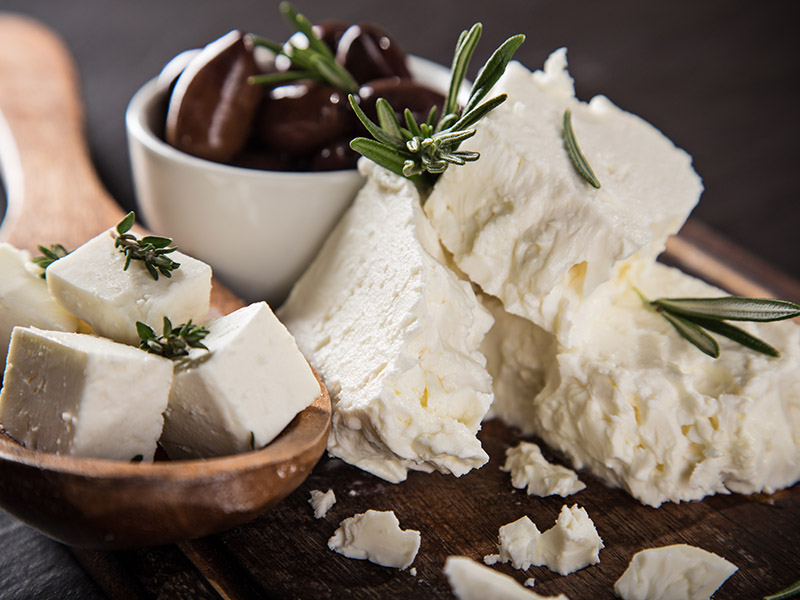
Production
The production processes have a major role in determining the taste and texture. From the sources of milk, the steps it takes to process raw milk, the ripening duration, to the seasonings that go into the making, Feta and goat cheese differ greatly.
Goat Cheese
Goat cheese is from 100% goat’s milk. The making of goat cheese involves the addition of bacteria culture and rennet to heated milk. This promotes the forming of raw milk into curds.
Once solid, the cheesemakers drain the liquid and whey from the curds. The subsequent step is to add salt to enhance flavors, and some shaping will follow suit.
Then, the cheese will undergo a ripening period that can last for a few days, weeks, or even months, depending on the variety.
The cheesemakers typically shape the cheese into logs. Cheesemakers also add spices, herbs, or other condiments to enhance and diversify the cheese’s flavor.
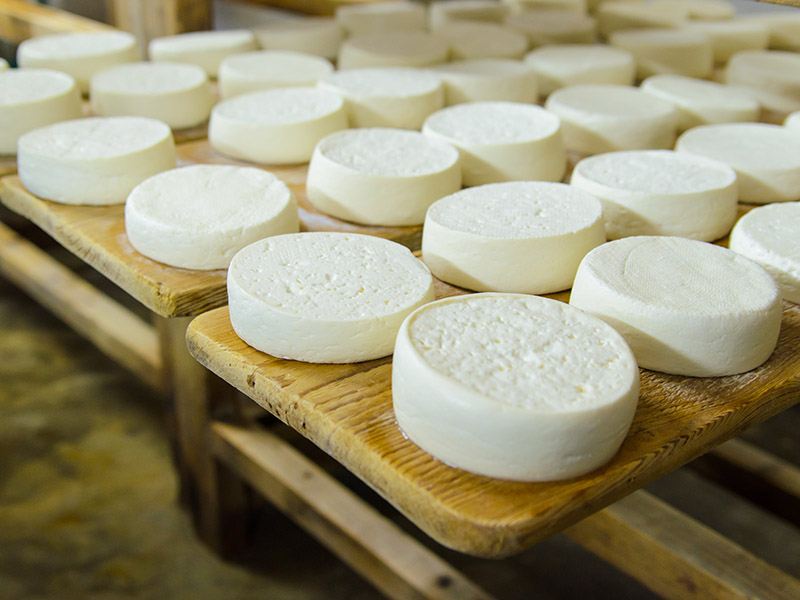
Feta Cheese
Like goat cheese, Feta cheese begins with warmed raw milk. In making Feta, the cheesemakers use raw sheep’s, goat’s, and even cow’s milk as the key output.
- Sheep’s milk: According to the Protected Designation of Origin (PDO), real Feta should only be produced in Greece, and the production needs to follow a set of given specifications.
Specifically, Feta can be derived from 100% sheep’s milk or with a sheep’s milk and no more than 30% goat’s milk mixed in (1).
- Cow’s milk: Feta produced outside the European region can be from cow’s milk. In fact, what most people eat in America is this mass-produced type of Feta. In this article, however, I’ll mainly discuss the officially recognized Feta version.
Either pasteurized or unpasteurized milk can go into the cheese-making process, although pasteurized milk is more commonly used. After going through pasteurization, the microorganisms that act as a starter culture vanish in the processed milk.
To compensate for this, the cheesemakers will add a culture bacteria and rennet if the pasteurized milk is used. This step creates curds that drain off the whey and transfer to molds to remove excess moisture.
The next step is to shape the cheese, season it with salt for more flavor, and let it dry. Finally, the resulting Feta goes into the brine, water mixed with 7% salt, to ripen. The cheese will stay in the brine for several weeks at room temperature.
Next, the cheesemakers will transfer it to refrigerated storage with high humidity, and the cheese continues to mature for a minimum of 2 months. Once the ripening completes, Feta goes into metal vessels or wooden barrels and is ready for consumption.
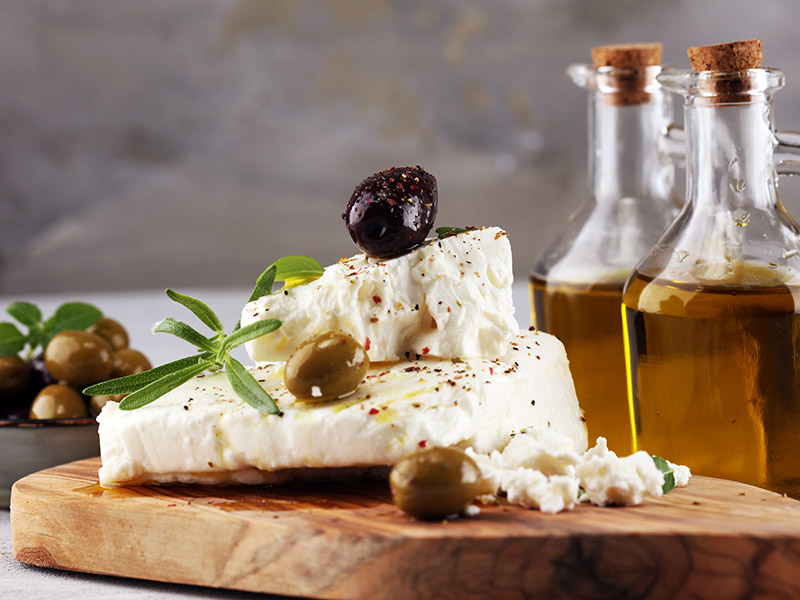
Appearance
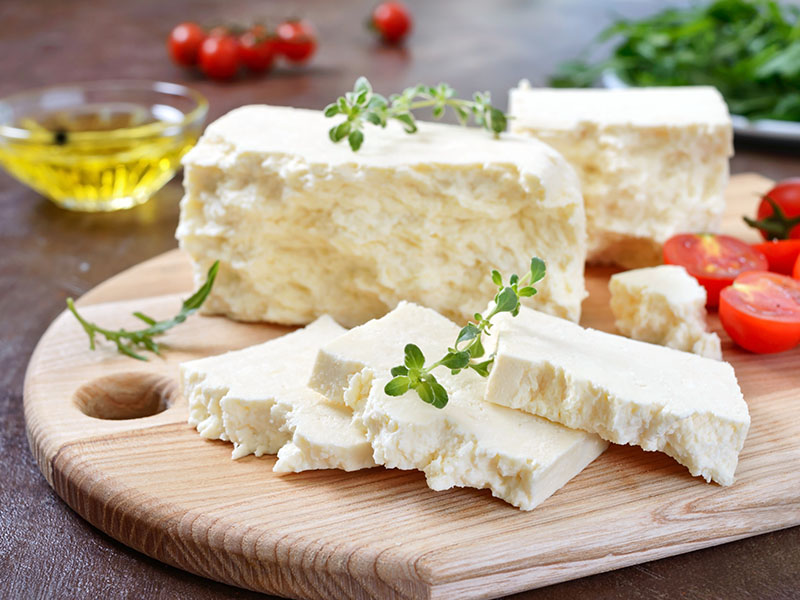
In general, both Feta and goat cheeses are white in color, although a few goat cheese varieties can take on other hues, such as ivory or pale yellow.
Texture-wise, goat cheese has a creamier mouthfeel than Feta. On the other hand, Feta tends to be more crumbly (hard Feta is likely to be crumbly, while the softer version can be more spreadable).
Yet, Feta generally has a firmer texture than goat cheese, although its exterior might feel slightly slimy because of the brine. The last point is that Feta has a bit of a grainy texture on the tongue.
Here are telltale signs to differentiate real and fake Feta.
Flavor
The difference in the milk sources leads to a noticeable difference in the flavor of these types of cheese.
Goat Cheese
Goats feed on the highest parts of the grass, where the leaves are the sweetest and most tender.
Therefore, their milk is distinctively bright, slightly acidic, and tangy, eventually imparting to the unique flavor of goat cheese. Goat cheese also comes with a barnyard-like and sometimes animal-like taste and aroma.
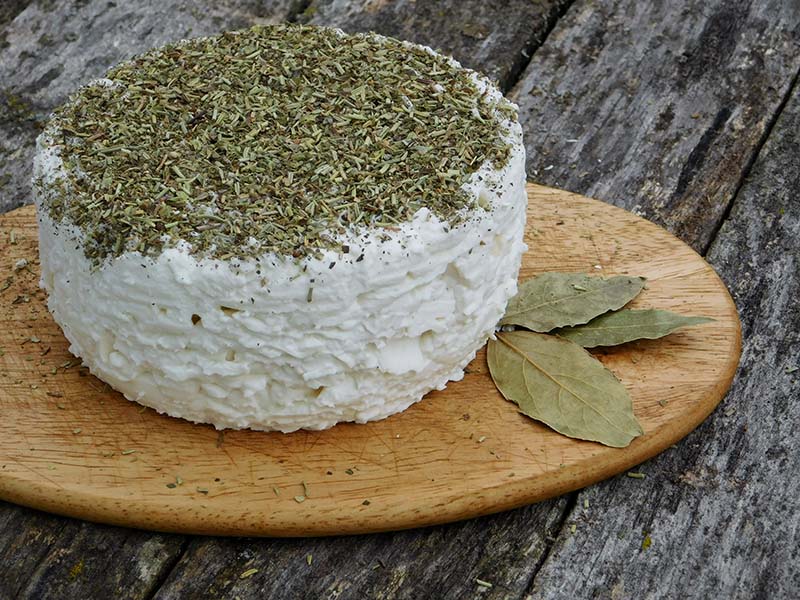
Feta Cheese
Feta’s taste varies greatly depending on the milk used in the manufacturing. However, because it ripens in the brine, all varieties tend to be saltier and tangy than goat cheese.
- Sheep’s milk
Sheep prefer to graze the tender and sweet top blade grasses. It also contains a whopping amount of fat. These factors make sheep’s milk rich, buttery, creamy, and less assertive.
These are also the characteristics of cheese produced from the milk. This Feta variety is also full-flavored and, at times, gamey.
- Sheep’s + goat’s milk
This is a milder version than the 100 percent sheep milk Feta. The less intense flavor (thanks to the addition of goat’s milk) makes this version a nice choice for those who find the above variety too gamey.
- Cow’s milk
You won’t get the nice full flavor from this variety. Instead, the cheesemaker adds more salt to the cheese to mask the lack of flavor of cow’s milk. The result is a saltier, sometimes sour, and less full-flavored cheese than the authentic version.
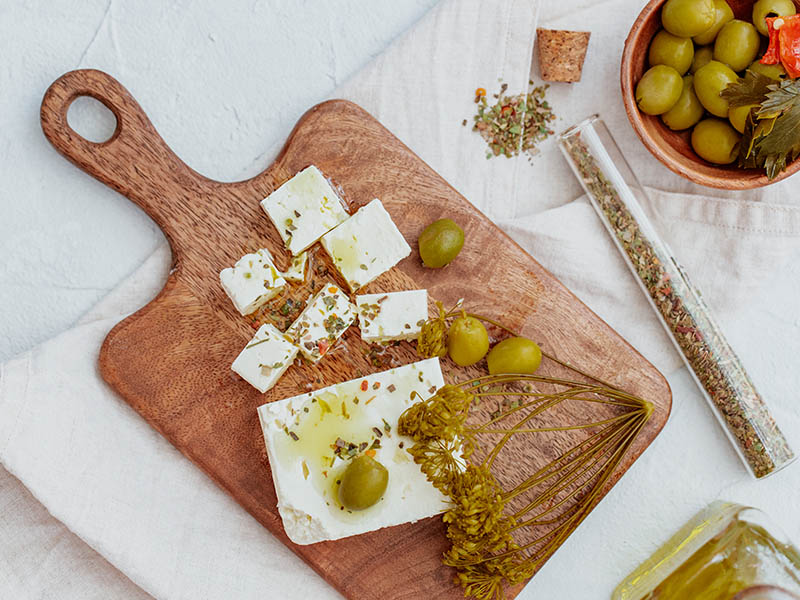
Nutritional Value
Due to different types of milk used in the process of cheese-making, these cheese variants have different nutritional values. Yet, spoiler alert, they’re both healthy options!
Calories
A 1.3-ounce piece of Feta cheese contains 100 calories, whereas there are up to 137 calories in the same amount of goat cheese. Plus, with its strong and salty flavor, you’ll use it more than goat cheese.
Probiotics
Goat cheese contains healthy probiotics such as L.acidophilus and L. Plantarum, which helps facilitate the digestive system and boost immunity. Greek Feta cheese also contains Lactobacillus Plantarum, which constitutes around 40% of its bacteria.
Calcium
Feta provides a healthy amount of calcium which amounts to 15% of daily intake. Goat cheese only offers 84 milligrams per ounce, equal to around 8% of the recommended daily dose.
Fat
In the same serving, goat cheese has 11 grams of fat, and saturated fat contributes to up to 38% of the daily value. Fat and saturated fat content is lower in Feta. The cheese only comes with 8 grams of fat per 1.3 ounces, with saturated fat at 28% of the daily value.
Nevertheless, fat in cheese variants is medium-chain triglycerides, less likely to stay in your body than in long-chain versions. Thus, you’re less likely to gain weight if you consume this fat in moderation.
Protein
Goat cheese provides slightly more protein than Feta cheese. Normally, in a 1-ounce serving, you’ll take into your body 6 grams of protein (12% daily value) from goat cheese, but only around 4 grams (8% daily value) from the Feta.
Sodium
Sodium content in Feta is twice in goat cheese, as the curds have stayed for quite a while in the brine. On average, a wedge of 1-ounce Feta cheese provides up to 323 milligrams, which translates to approximately 14% of recommended daily value.
However, the same amount of chevre comes with only 118 milligrams – equal to around 7% of the daily value.
Lactose
According to a study, lactose content in Feta cheese doubles that in goat cheese (3). Unlike cow cheese, both types of cheese primarily contain A2-beta casein instead of A1-beta casein.
This protein variant is easier to digest, making it a healthier option for those with digestive issues or mild lactose intolerance.
Other Nutrients
The phosphorus content of goat cheese makes up around 10% of recommended dietary intake. Goat cheese also has higher B vitamins such as vitamin B6 Riboflavin (vitamin B2), and thiamine.
These B vitamins play a significant role in regulating your energy levels, nervous system, and cell metabolism.
In addition, goat cheese is rich in vitamin A, more than three times the international units in Feta cheese. There are also greater amounts of vitamins D, E, and K found in goat cheese.
Feta cheese is higher in phosphorus – a mineral contributing to bone and teeth formation. On average, one serving of Feta (1-ounce) provides your body with roughly 96 milligrams, approximately 15% of recommended dietary value.
Other nutrients that you can benefit from Feta cheese include vitamins A and K, iron, folate, magnesium, and pantothenic acid.
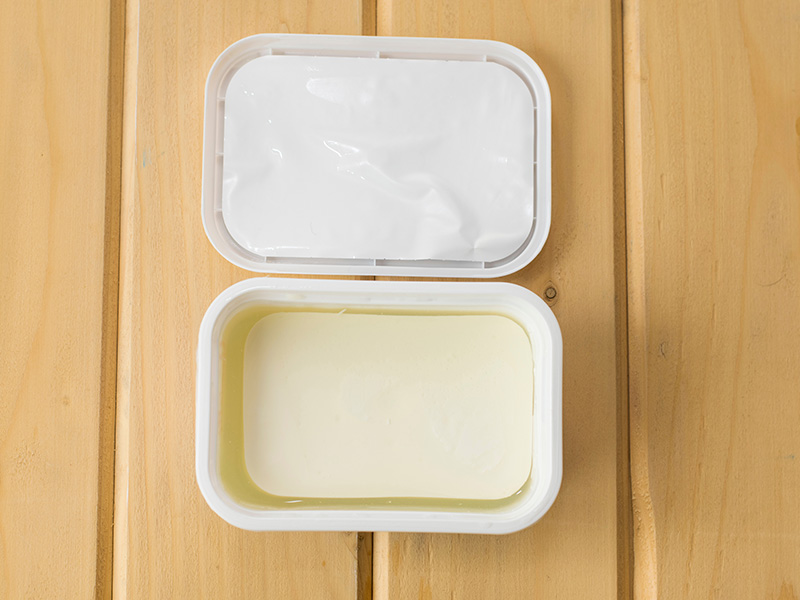
Price
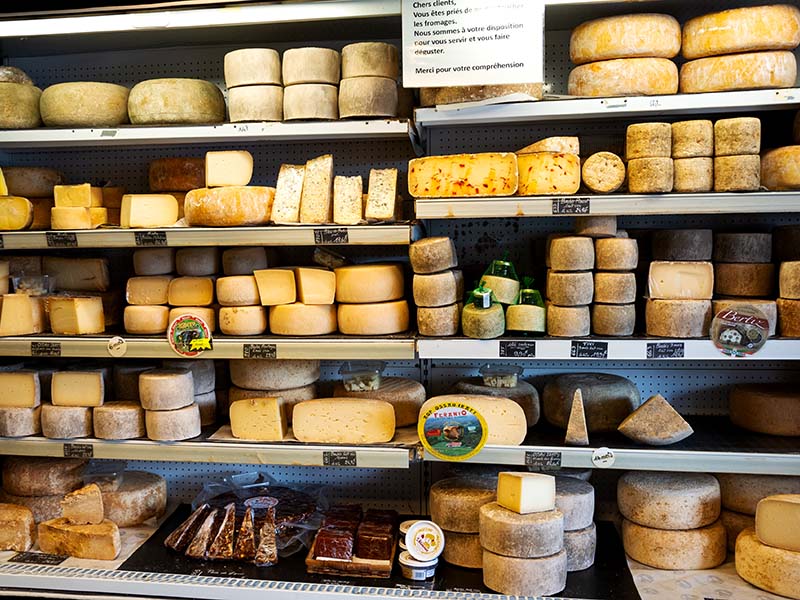
The price of the cheese can is a determining factor in which cheese people might choose. The production of goat cheeses only takes place in some regions, meaning they are less readily available than Feta.
For this reason, goat cheese is generally higher in price, leading many people searching for other replacements for goat cheese. Fortunately, the manufacturing of goat cheese has grown consistently over the past few years, leading to a drop in its price.
However, when stacking goat cheese against Feta in terms of price, goat cheese is still slightly more expensive.
Go for this homemade Feta cheese recipe, and you’ll never return to the store-bought version again.
Which Cheese Should You Choose?
Feta and goat cheese are quite different in flavor and texture. This means you can evaluate your options based on your recipes and preferences.
Feta is a delicious complement to sauces, dressing, and greens, and therefore, it’s a preferred ingredient in Greek and French cuisines (the classic Greek salads). As mentioned, Feta is saltier than goat cheese, making it ideal for dishes that call for a salty punch.
Sharing many commons with cream cheese in texture and taste, goat cheese can elevate the flavor of heavy and savory dishes.
On the other hand, due to its high sodium content, you should not go for Feta if you have conditions such as heart failure or high blood pressure.
In terms of price, Feta is not only more affordable but also more widely available, so you don’t need to hunt down the cheese.
Feta and goat cheeses also slightly differ in nutritional values. They are both healthy options for your health, but Feta should be a better choice if you’re monitoring your calories.
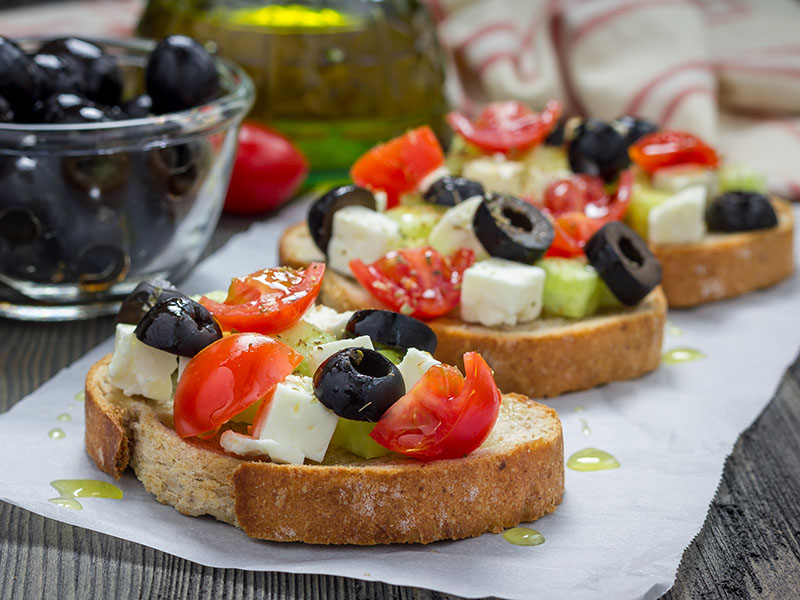
Can You Substitute Feta For Goat Cheese?
Yes, you can use the two kinds of cheese interchangeably in many recipes.
As mentioned above, Feta has a crumbly texture, while goat cheese is on the creamier and more spreadable side. This means if you want to replicate the Feta’s texture, aged goat cheese, which comes with a crumbly texture, is a better choice.
Feta and goat cheese take the role of each other in salads, sandwiches, or omelets. Because Feta is saltier, it’s best to use less Feta than you would with goat cheese.

How To Use Goat Cheese And Feta Cheese
There are many factors to differentiate Feta from goat cheese. However, you can use the two types of cheese interchangeably in some recipes. Below are four classic ways to enjoy them:
On A Charcuterie Cheese Board Or Meat

With their distinctive flavors and textures, there is no perfect place for these two kinds of cheese to gather rather than a cheese board. They add variety to the plate, alongside traditional options such as Brie, Cheddar, Gouda, or Manchego.
Check out this ultimate guide on incorporating chevre into charcuterie cheese board.
As A Flavorsome Dip
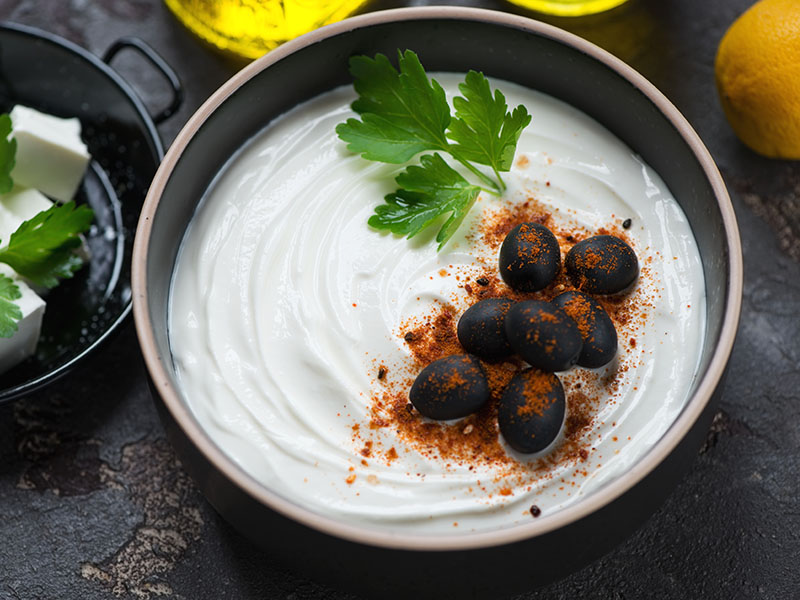
Both have a creamy and soft texture that can be awesome as a whipped dip. Throw in the garlic, herbs, olive oil, lemon juice, and other seasonings to boost the flavor.
You may want to include some Greek yogurt in the mix, which can balance out the saltiness of the Feta and add an extra tang.
Over French Bread, Crostini For Bruschetta
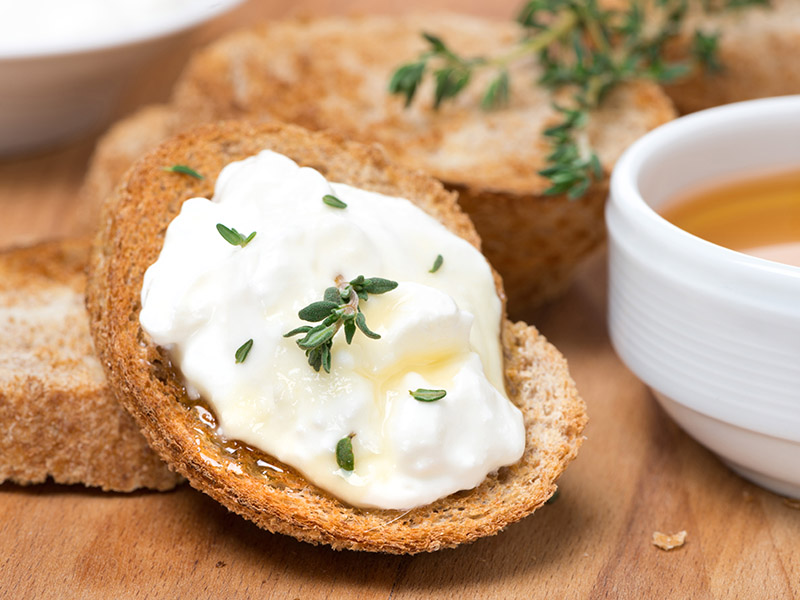
Toppings for crostini are diverse, including tapenades, roasted veggies, prosciutto, fruits, and of course, savory cheese.
Spread whipped goat cheese or Feta onto slices of crostini to create a barrier against the sogginess of roasted veggies. Then, add bell pepper, zucchini, eggplant, or whatever you like on top, along with jam or some olives.
As A Salad Topping
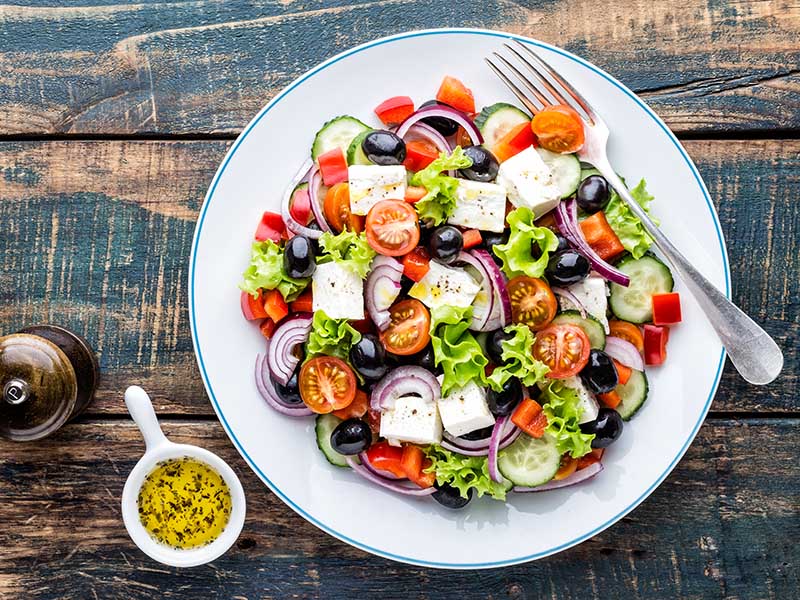
Salads are one of the most common ways to use goat cheese. It can pair well with many other ingredients, from beet, roasted veggies, crunchy nuts, and sweet apples to cranberries.
A classic Greek salad recipe often includes sliced tomatoes, cucumbers, bell pepper, red onions, some olives, and the star of the show – Feta cheese. The cheese goes harmoniously with these veggies, making for a refreshing and flavorful dish.
Interestingly, while Feta is the default choice in Greek salads, you can make a twist by swapping it with goat cheese.
Feta Greek salads are among the must-try dishes in Greek cuisine.
FAQs
Now you know the basic differences between the two cheese variants. If you consider trying either of them (or both), you might stumble on some of these most commonly asked questions below:
They’re Fabulous Options To Try
Feta and goat cheeses are tasty, filling, and nutritious. You can feel good about eating these cheeses in moderation. I advise using them as a flavoring agent instead of a meal itself; then, you can enjoy all of their benefits.
It all comes down to your preferences in choosing which cheese to eat; beware of the high sodium content in Feta. Or, you can have the best of both worlds – enjoy both types of cheese.
Is there anything I haven’t addressed about this topic? If yes, you can comment in the section below. And if you find this post helpful, don’t forget to share this post with your cheese-lovers in life.
References
- ec.europa.eu. Feta FDO.
- healthline.com.. Is Feta Goat Cheese?
- ift.onlinelibrary.wiley.com. 2017. Sheep Milk: Physicochemical Characteristics and Relevance for Functional Food Development.




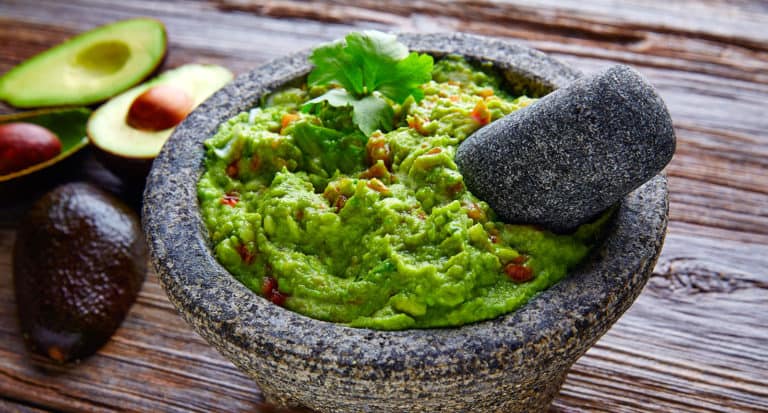

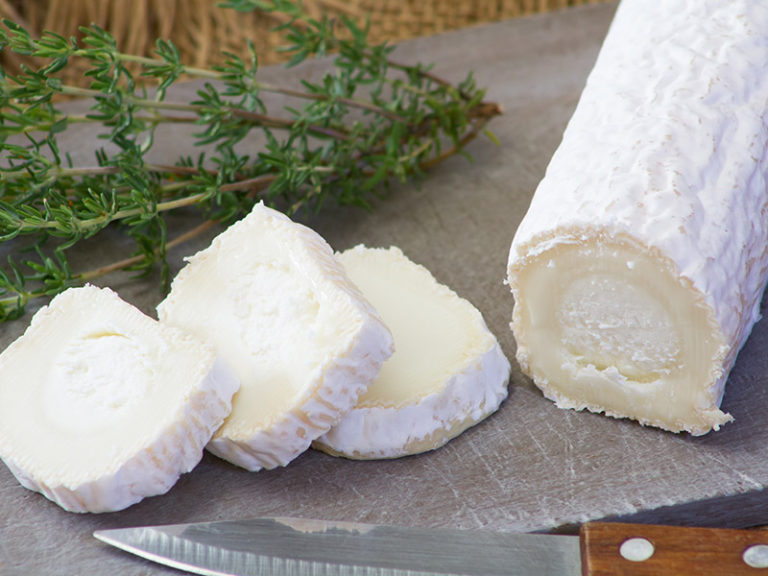
Amanda Collins
Founder and Senior Culinary Editor
Expertise
Culinary Arts and Management, Food Journalism and Critique, Recipe Development and Testing, Global Culinary Traditions, Sustainable Food Practices
Education
Institute of Culinary Education (ICE), New York, NY
Program: Diploma in Culinary Arts
Focus: Intensive hands-on training in culinary techniques, recipe development, and kitchen management, preparing students for professional roles in the culinary industry.
Monroe College, New Rochelle, NY
Program: Associate in Applied Science in Culinary Arts
Focus: Practical culinary skills, including cooking techniques, menu planning, and kitchen operations, with an emphasis on hands-on experience and industry standards.
Amanda Collins is a seasoned chef and food editor with a deep love for global flavors. Trained at the Institute of Culinary Education and Monroe College, and with over 15 years in the culinary field, Amanda has refined her skills in kitchens worldwide. Her background in food studies gives her a unique ability to share both recipes and the cultural stories that shape them.
As senior culinary editor at thebreslin.com, Amanda’s work brings authentic dishes to life, inviting readers to explore new flavors and techniques from around the globe. Her approachable style makes it easy for anyone to bring a bit of the world’s cuisine into their kitchen.